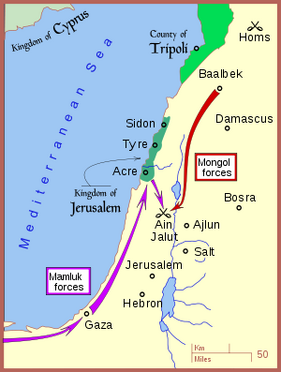
Mongols at 'Ayn Jalut
The Mongols were quite possibly the geatest nation to have ever existed, their borders surpassing that of the Roman Empire and even Alexander the Great. But in 1260, the fate of the entire Empire rested on one battle.
The Backdrop
When Genghis Khan died in 1227, his empire stretched from eastern Russia to the Middle East. He left his power to his children and grandchildren; one of these was Hülegü Khan, who was given power over part of the Mongol army.
He took his army to northwest Persia in 1255, raiding and pillaging as they went. In 1258, he defeated the Abbasid Caliphate at the Battle of Baghdad, capturing and destroying the city, and massacring the inhabitants. The Mongols now controlled Iraq and Persia. From here they pushed westwards toward the the Mediterranean. They overran Palestine and Syria, capuring the main city Damascus, in 1259. With Palestine and Syria conquered, Hülegü turned his attention to Egypt.
He sent a message to its ruler, Qutuz of the Mamluks, asking them to surrender without a fight:
- "From the King of Kings of the East and West, the Great Khan. To Qutuz the Mamluk, who fled to escape our swords. You should think of what happened to other countries and submit to us. You have heard how we have conquered a vast empire and have purified the earth of the disorders that tainted it. We have conquered vast areas, massacring all the people. You cannot escape from the terror of our armies. Where can you flee? What road will you use to escape us? Our horses are swift, our arrows sharp, our swords like thunderbolts, our hearts as hard as the mountains, our soldiers as numerous as the sand. Fortresses will not detain us, nor arms stop us. Your prayers to God will not avail against us. We are not moved by tears nor touched by lamentations. Only those who beg our protection will be safe. Hasten your reply before the fire of war is kindled. Resist and you will suffer the most terrible catastrophes. We will shatter your mosques and reveal the weakness of your God and then will kill your children and your old men together. At present you are the only enemy against whom we have to march."
Qutuz refused to surrender however, killed the envoys sent to deliver the message, and paraded their bodies though the centre of Cairo.
But then something happened that changed the tide for the Mamluks. The Great Khan of the Mongols, Mongke, died while on an expidition in China. This meant that Hülegü and other senior Mongols were required to return home to decide apon Mongke's successor. A potential Great Khan, Hülegü took most of his army with him, leaving around 15,000 men under the command of his best general, Nestorian Christian Naiman Turk Kitbuqa Noyan (a mouthful, I know). In late August, Kitbuqa took his forces south from their camp in Baalbek, passing to the east of Lake Tiberias (the Sea of Galilee).

Movement of Forces
In an unusual action, the Crusader Kingdom of Jerusalem had allowed the Mamluks to march through Crusader territory, and set up camp in Acre. When the message came that the Mongols had crossed the Jordan River, Sultan Qutuz and his army began to march southeast, toward a spring called 'Ayn Jalut (Goliath Spring) in the Jezreel Valley. There they met the Mongol forces and the battle ensued.
The opposing forces met on the 3rd of September 1260, both sides numbering around 15-20,000 men.
The first to advance were the Mongols, whose force also included troops from the Kingdom of Georgia and about 500 knights from the Armenian Kingdom of Cicilia, both of which had submitted to Mongol authority. The Mamluks had the advantage of knowing the terrain, and Qutuz made the most of this by hiding the bulk of his force in the highlands, hoping to bait the Mongols by using a smaller force. The two forces fought restlessly for several hours, with the Mamluks using hit-and-run tactics. When the Mongols carried out another heavy assault, the Mamluks feigned a final retreat, drawing the Mongols into the highlands to be ambushed by the rest of the Mamluk forces, who were concealed among the trees in the highlands. At this point, Kitbuqa had to make a decision. This decision would change the face of the world forever. The Point of Divergence.
In OTL, Kitbuqa led his forces into the highlands, only to be ambushed and defeated outright. Never before defeated outright in open warfare, military progress came to an abrupt halt and ceased. With no population to support the lands in the wake of the advancing army, the nation collapsed in on itself and fragmented into several independant states, marking the end of the Mongol Empire.
In this ATL, Kitbuqa halted his army and ignored the bait. Impatient, Qutuz led his army in a full on charge out of the woodlands, only to be met by a well prepared Mongol army. Terrified by the calm yet savavge demeanor worn by the Mongols, some of the Mamluk army turned and fled. This left Qutuz outnumbered two to one. The battle was over in less than an hour. A victory for the Mongols.
